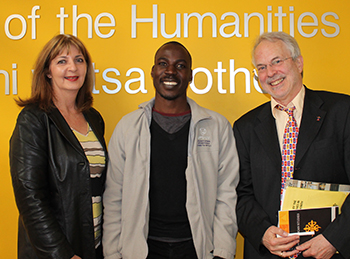Latest News Archive
Please select Category, Year, and then Month to display items
24 September 2024
|
Story Aimée Barlow
|
Photo Supplied
 Louzanne Coetzee, who made history by clinching South Africa’s second medal at the Paralympics, earning a bronze in the T11 1 500 m women’s final with a personal best time, received a warm reception when she recently returned home.
Louzanne Coetzee, who made history by clinching South Africa’s second medal at the Paralympics, earning a bronze in the T11 1 500 m women’s final with a personal best time, received a warm reception when she recently returned home.
The celebrated Paralympic bronze medallist Louzanne Coetzee returned home to a warm welcome at the Bram Fischer International Airport on 10 September 2024.
Family, friends, colleagues, Arista students, and media gathered to celebrate her remarkable achievement and show their support.
Coetzee – KovsieSport Coordinator of Parasport at the University of the Free State (UFS) – made history by clinching South Africa’s second medal at the Paralympics, earning a bronze in the T11 1 500 m women’s final with a personal best time. Her dedication and hard work have not only brought her personal glory but have also inspired many in her community.
Among those present to welcome her was Jerry Laka, Director of KovsieSport, who expressed his pride in Coetzee’s accomplishments.
"We as KovsieSport are so proud of our colleague Coetzee. It is amazing to see a product of KovsieSport achieving greatness on the world stage. She is truly an inspiration to us all," said Laka.
“I am so glad to be back, and to have Laka and my colleagues here. It means the world to me. Having Laka here shows his commitment to my career and ParaSport and his staff in general,” shared Coetzee, her gratitude evident.
She further expressed her appreciation for the support she received, stating, “I don’t have the words to describe how thankful I am for the support from the UFS community.”
Coetzee’s return is a proud moment for South Africa and the University of the Free State (UFS) community. Welcome home, Louzanne! Your achievements have made us all proud!
Expert in Africa Studies debunks African middle class myth
2016-05-10

From left: Prof Heidi Hudson, Director of the Centre for Africa Studies (CAS), Joe Besigye from the Institute of Reconciliation and Social Justice, and Prof Henning Melber, Extraordinary Professor at the CAS and guest lecturer for the day.
Photo: Valentino Ndaba
|
Until recently, think tanks from North America, the African Development Bank, United Nations Development Plan, and global economists have defined the African middle class based purely on monetary arithmetic. One of the claims made in the past is that anyone with a consumption power of $2 per day constitutes the middle class. Following this, if poverty is defined as monetary income below $1.5 a day, it means that it takes just half a dollar to reach the threshold considered as African middle class.
Prof Henning Melber highlighted the disparities in the notion of a growing African middle class in a guest lecture titled A critical anatomy of the African middle class(es), hosted by our Centre for Africa Studies (CAS) at the University of the Free State on 4 May 2016. He is an Extraordinary Professor at the Centre, as well as Senior Adviser and Director Emeritus of the Dag Hammarskjöld Foundation in Sweden.
Prof Melber argued that it is misleading to consider only income when identifying the middle class. In his opinion, such views were advanced by promoters of the global neo-liberal project. “My suspicion is that those who promote the middle class discourse in that way, based on such a low threshold, were desperate to look for the success story that testifies to Africa rising.”
Another pitfall of such a middle-class analysis is its ahistorical contextualisation. This economically-reduced notion of the class is a sheer distortion. Prof Melber advised analysts to take cognisance of factors, such as consumption patterns, lifestyle, and political affiliation, amongst others.
In his second lecture for the day, Prof Melber dealt withthe topic of: Namibia since independence: the limits to Liberation, painting the historical backdrop against which the country’s current government is consolidating its political hegemony. He highlighted examples of the limited transformation that has been achieved since Namibia’s independence in 1990.